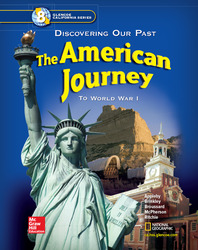

Discovering Our Past: The American Journey to World War IChapter 8: The Northeast: Building IndustryChapter OverviewIn the mid-1700s, inventors in Great Britain created machinery to perform some of the work involved in cloth making. These innovations led to changes, not only in industry, but also in the way people lived. The British tried to keep their new industrial technology a secret. However, one man, Samuel Slater, memorized the design of some of the machines and then immigrated to the United States. In Rhode Island he took over the management of a cotton mill and duplicated many of the new designs. As the Industrial Revolution spread through the United States, new technology contributed to the growth of cities and agriculture.During the 1800s Americans moved west of the Appalachian Mountains in increasing numbers. To support the movement of people and goods, roads and canals were built connecting the East with the Ohio River valley. Transportation routes such as roads improved as settlers moved west, and steamboats greatly improved the transport of goods along rivers. Business and government officials came up with a plan to build a canal to link the eastern and western parts of the country. Americans continued to move even further westward, settling near rivers so they could ship their crops to market. As industrialism grew in the North, many saw the need for reforms in working conditions. Immigrants from many parts of Europe settled in northern U.S. cities. Nativists opposed immigration because they feared losing their jobs to immigrants who would work long hours for less money. In the early 1800s a spirit of reform swept through America. The Second Great Awakening, a religious revival, inspired people to become involved in missionary work and social reform movements. The temperance movement warned of the dangers of alcoholic beverages. Horace Mann was a leader in education reform. By the 1850s most states began to move toward free, public education for all students. Other reformers focused on improving life for those with special needs. The right to vote was an important part of the women's movement. A convention was held at Seneca Falls, New York, in 1848. There a call was made for an end to all laws that discriminated against women. Elizabeth Cady Stanton, Lucretia Mott, and Susan B. Anthony were famous leaders of the women's movement. |  |















